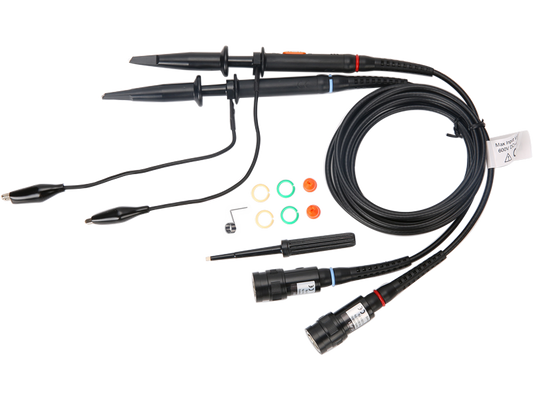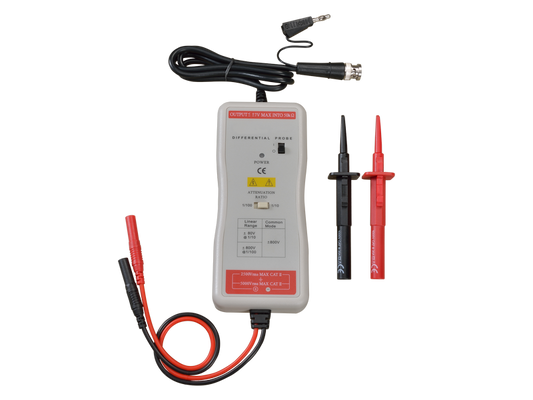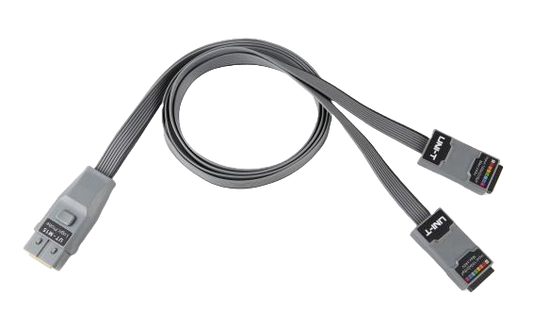Key Features
• Comprehensive jitter analysis views: Eye Diagram, Trend Chart, Histogram, TIE spectrum, and Bathtub Curve
Compatibility Information
Compatible Models: MSO8804HD
Installation: Software license activation - no hardware modification required
Bandwidth Utilization: Full oscilloscope bandwidth for maximum timing resolution
Sample Rate: Optimized for 10-20 GSa/s operation depending on channel configuration
Bundle Savings Opportunity
This option is included in the MSO8000HD-BND Protocol Analysis & Jitter Suite ! Get this capability plus 15 other protocol analysis options and jitter analysis for just $5,399 - saving you $10,583 (66% off) compared to purchasing options individually.
The bundle features perpetual licensing with zero recurring fees, potentially saving $10,000+ over the instrument's lifetime compared to competitors' subscription models.
UNI-T MSO8000HD-JITTER Analysis Capabilities
Comprehensive Jitter Measurement Suite
The JITTER option provides a complete arsenal of timing measurements essential for high-speed digital design validation. Time Interval Error (TIE) measurements reveal timing deviations from ideal clock edges, while cycle-to-cycle and period jitter measurements characterize short-term and long-term timing variations. These measurements are critical for understanding clock stability and predicting system timing margins.
Advanced jitter decomposition separates total jitter into its random and deterministic components, enabling engineers to identify specific jitter sources and optimize system performance. Random jitter analysis reveals thermal noise and other stochastic effects, while deterministic jitter measurements identify systematic timing errors from crosstalk, power supply noise, and other predictable sources.
Multi-domain analysis correlating timing measurements with signal characteristics
Professional Eye Diagram Analysis
Eye diagram analysis provides intuitive visualization of signal quality and timing margins, essential for validating high-speed digital communication systems. The JITTER option automatically measures critical eye parameters including eye height, eye width, crossing percentage, and rise/fall times. Statistical analysis of eye measurements reveals signal integrity trends and enables prediction of system performance under varying conditions.
Advanced eye diagram features include template compliance testing, mask overlay analysis, and criteria evaluation. These capabilities enable production testing applications and ensure compliance with industry standards for high-speed digital interfaces.
Statistical Analysis and BER Prediction
Total jitter extrapolation to specific bit error rates (TJ@BER) enables engineers to predict system performance and establish timing budgets for high-reliability applications. The statistical analysis engine processes thousands of timing measurements to generate accurate jitter histograms and cumulative distribution functions, providing the data quality needed for confident BER predictions.
Bathtub curve analysis visualizes the relationship between timing margins and error rates, enabling optimization of sampling phase and timing budgets. This analysis is particularly valuable for clock and data recovery system design and validation.
Multi-Domain Correlation Analysis
The TIE spectrum display reveals the frequency domain characteristics of timing jitter, enabling identification of specific jitter sources and their correlation with system clocks, power supplies, and other potential interference sources. This frequency domain analysis is essential for root-cause analysis of timing problems and optimization of system EMI performance.
Professional Applications
High-Speed Serial Interface Validation
Validate timing performance of high-speed serial interfaces including USB, PCIe, SATA, and Ethernet connections. Comprehensive jitter analysis ensures compliance with industry timing specifications and enables optimization of signal integrity for maximum data throughput and reliability. Eye diagram analysis reveals signal quality margins and identifies potential interoperability issues before system integration.
Clock Distribution System Analysis
Characterize clock distribution networks, phase-locked loops, and clock generation circuits with precision timing measurements. Period jitter and cycle-to-cycle jitter measurements reveal clock stability performance, while TIE analysis identifies systematic timing errors from clock distribution skew and jitter accumulation. These measurements are critical for timing closure in high-performance digital systems.
Memory Interface Timing Verification
Validate timing margins for DDR memory interfaces, high-speed processors, and FPGA-based systems. Setup and hold time analysis combined with jitter measurements ensures robust operation across temperature and voltage variations. Statistical timing analysis enables worst-case timing verification and optimization of memory controller settings for maximum performance.
Communication System Design Validation
Analyze clock and data recovery performance in communication systems, including clock extraction accuracy, data demodulation fidelity, and clock reconstruction quality. Jitter tolerance testing validates receiver performance under various jitter conditions, while jitter transfer analysis characterizes system response to upstream timing disturbances.
Frequently Asked Questions
What is the difference between random jitter (RJ) and deterministic jitter (DJ)?
Random jitter is unpredictable timing noise with a Gaussian distribution, typically caused by thermal noise and other stochastic effects. Deterministic jitter consists of systematic timing errors with bounded peak-to-peak values, caused by predictable sources like crosstalk, power supply noise, and signal integrity issues. The JITTER option separates these components to enable targeted optimization.
How accurate are the TJ@BER extrapolations for reliability predictions?
The TJ@BER calculations use proven statistical methods based on the dual-Dirac model for jitter decomposition. Accuracy depends on the quality of the random and deterministic jitter separation and the number of samples collected. For most applications, extrapolations to BER levels of 10^-12 provide reliable predictions for system timing budgets.
Can the JITTER option analyze multi-level signaling like PAM-4?
Yes, the JITTER option supports analysis of various signaling formats including NRZ, PAM-4, and other multi-level schemes. Eye diagram analysis automatically adapts to the signal characteristics, providing appropriate measurements for each signal level and transition type.
What is the minimum sample rate required for accurate jitter measurements?
For optimal jitter analysis, we recommend using the maximum available sample rate of your oscilloscope. The MSO8000HD's 20 GSa/s sample rate provides excellent timing resolution for sub-picosecond jitter measurements. Lower sample rates may still provide useful results depending on the application requirements.
How does the TIE spectrum help identify jitter sources?
The TIE spectrum shows the frequency domain characteristics of timing jitter, revealing spectral peaks that correspond to specific interference sources. Power supply noise, clock feedthrough, and crosstalk from adjacent channels typically appear as distinct peaks in the spectrum, enabling engineers to identify and address specific jitter sources.
Is training available for the advanced jitter analysis features?
Yes, UNI-T provides comprehensive training materials including user manuals, application notes, and video tutorials covering all aspects of jitter analysis. Technical support is available to assist with specific measurement challenges and optimization of analysis parameters for your applications.
Is this option included in any bundle packages?
Yes, the Advanced Jitter Analysis and Eye Diagram option is included in the MSO8000HD-BND Protocol Analysis & Jitter Suite . The bundle provides 15 protocol analysis options plus advanced jitter analysis at a single price of $5,399 - saving 66% compared to purchasing options individually. As with all UNI-T software options, the bundle features a perpetual license with zero recurring fees, providing lifetime access without subscription costs that can save $10,000+ over the instrument's lifetime.
Master Signal Integrity Analysis
The MSO8000HD-JITTER option transforms your oscilloscope into a comprehensive signal integrity analysis platform, delivering the professional-grade jitter measurements and eye diagram testing capabilities essential for validating modern high-speed digital communications. From statistical BER predictions to multi-domain jitter correlation, this option provides the depth of analysis required for both cutting-edge design validation and production testing.
Ready to unlock advanced timing analysis? Order the MSO8000HD-JITTER or get it included in the MSO8000HD-BND Complete Suite for maximum value and comprehensive analysis capabilities.
































